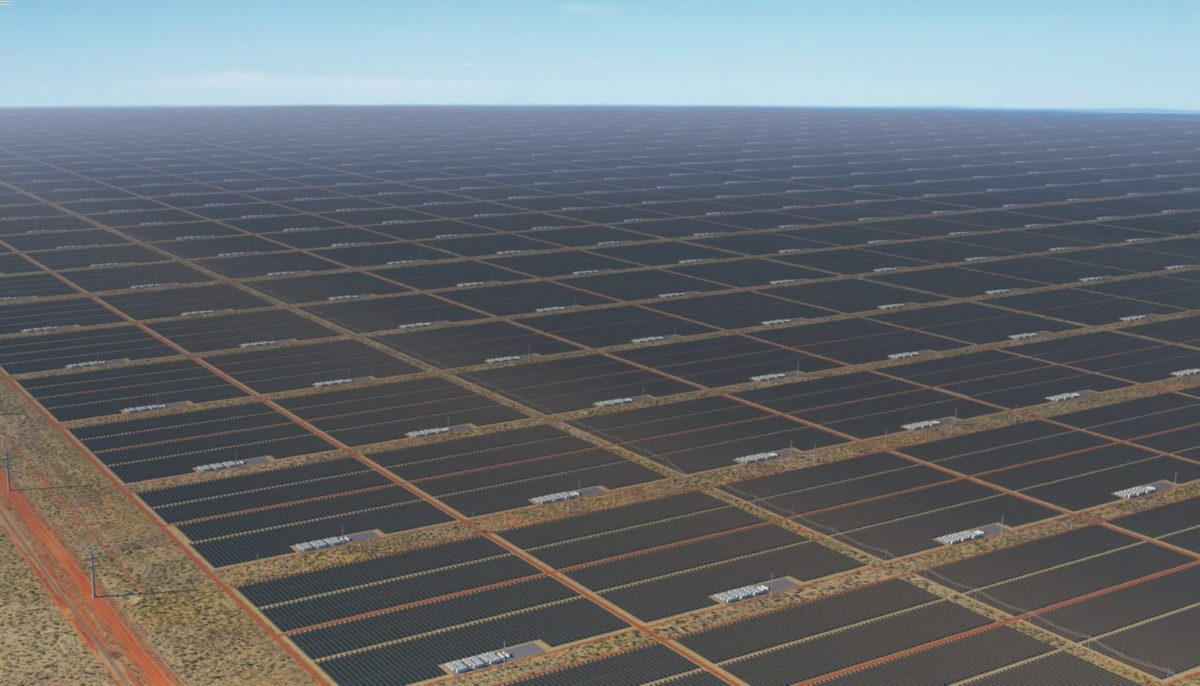Singapore-based Sun Cable, the company planning on building the world’s biggest solar and battery energy storage project in the Northern Territory (NT) and exporting it to Singapore, has lodged an Environmental Impact Statement (EIS) Summary revealing the full extent of its enormity.
According to the EIS, the $30 billion-plus Australia-Asia PowerLink (AAPL), which already has financial support from Australian billionaires Mike Cannon-Brookes and Andrew Forrest, is set to generate its renewable energy via a 17-20 GW solar farm with 36-42 GWh of battery energy storage called the Powell Creek Solar Precinct, occupying 12,000 hectares in the NT’s Barkly region.

The Maverick prefabricated and pre-wired system, designed by Sydney manufacturer 5B, has been named as the preferred solar technology supplier for the AAPL project. Arrays will be arranged in blocks of approximately 23-28 MW DC peak capacity and tied into about 60 MWh of storage.
From the Powell Creek site, an 800 km 6.4 GW overhead transmission line will carry the solar energy to the Darwin Converter Site at Murrumujuk, where approximately 800 MW of it will be supplied to Darwin and for private industry offtake. The rest will push on to Cable Transition Facilities at Gunn Point Beach where up to six 4,200 km subsea cable system laid parallel will transmit the energy to Singapore.

The document presents the project’s key benefits as being the reduction of greenhouse gas emissions by 480 million tonnes over the project’s 70-year lifespan (equivalent to the average electricity used by more than 2.5 million Australian homes annually, and saving 10% of the NT’s greenhouse gas emissions).
Moreover, the megaproject will create 1,750 construction jobs in the NT as well as 350 long-term operational jobs.
Sun Cable chief executive David Griffin told the ABC: “The lodgement of the EIS to the NT [Environment Protection Authority] is a significant milestone for the AAPowerLink.”
Popular content

Of course, no megaproject is without potentially negative environmental impacts. The EIS report identified impacts on vulnerable plant species including Darwin Cycads and Typhonium pratermissum at the Converter site.
According to the ABC, the project’s proponents said it was unlikely to affect fauna, such as the Greater Bilby, the Yellow-spotted Monitor and eight threatened species of migratory shorebirds. Nor are the cables said to have impacts of extra noise and electromagnetic fields on turtles, dugongs, pygmy blue whales and whale sharks.
United States-based engineering, procurement and construction (EPC) giant Bechtel, North American transmission specialist Hatch, professional services firms Marsh and PwC Australia, and Australia-headquartered engineering outfit SMEC, a member of the Singapore-based Surbana Jurong Group, have been listed as members of the project delivery team.
The AAPowerLink is the latest in a long line of renewable energy projects SMEC has worked on in Australia. The company said it has been directly involved in the development of more than 6.4 GW worth of utility-scale solar farms in Australia, including Risen Energy’s 100 MW Yarranlea Solar Farm in Queensland and the massive 720 MW New England Solar Farm being developed in New South Wales by UPC/AC Renewables Australia.
SMEC is also involved in Project EnergyConnect, a 900km proposed electricity interconnector being delivered by network operators TransGrid and ElectraNet and the $4.6 billion Snowy 2.0 pumped hydro project, which when complete will provide 2 GW of dispatchable, on-demand renewable power and approximately 350 GWh of large-scale energy storage to the National Electricity Market (NEM).
Sun Cable believes the project will have the capacity to supply 15% of Singapore’s energy requirements. The financial close of the project is expected in late 2023, with construction beginning as early as 2024. An Indigenous Land Use Agreement is under negotiation with the native title holders through the Northern Land Council.
The EIS is open for public submissions until July 15.
This content is protected by copyright and may not be reused. If you want to cooperate with us and would like to reuse some of our content, please contact: editors@pv-magazine.com.



we should do this in Europa too
Would this be necessary if Humanity follows a more responsible, equatable deflate the bubble path? No
Doesn’t this make more sense if we are sending solar power east rather than west? At the time of day when Singapore’s demand is near its maximum, our giant solar farm will be watching the sunset. But if this was built on our west coast and cabled to our east coast then our main population centres can receive solar power deep into the evening when demand is a maximum.
Re: Mark Hardy – correct, but that is why battery storage is collocated to allow for time-shifting of renewables.
The reason this is happening is because Singapore physically doesn’t have enough space to install such a vast system themselves. I wouldn’t be surprised if we saw this in other significantly dense cities (Tokyo, Rio, etc)